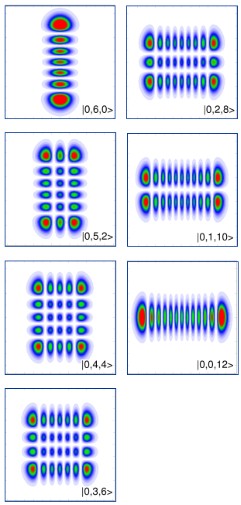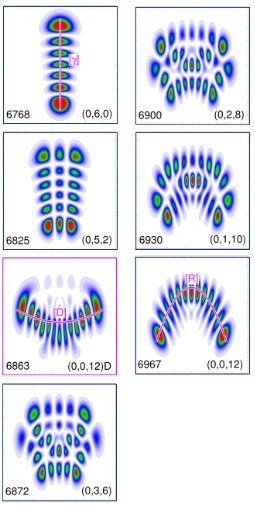| |
| Bifurcation
of periodic orbits versus birth of new quantum modes in highly excited vibrational
dynamics
(HCP, DCP, HOCl, HOBr, O3, ...) |
 |
 |
 |
| Wave functions of the seven states of HOBr with a total of 12 quanta of excitation in the OBr stretch (abscissae) and bend (ordinates) degrees of freedom, according to naïve Harmonic Oscillator predictions (left) and more realistic calculations (right). The difference is due to the Fermi resonance between the two modes, which is responsible for the saddle-node bifurcation where the [D] family of periodic orbits is born. |
|
|
|
At low energies, close to the bottom of the potential energy surface, the vibrational motion of a
molecule is well described by the normal modes formalism. However, when the energy increases, non-linear couplings (like
the Fermi or the Darling-Dennison resonances) set in, which eventually lead to bifurcations. Bifurcations are real discontinuities
of the classical phase space, where fundamental families of periodic orbits are created, destroyed, or change their stability
properties. Since the classical periodic orbits form the backbones of the quantum mechanical wave functions, classical bifurcations
obviously make the quantum spectrum more complicate... and more interesting (see the figure above).
Since experimental set-ups and computer allow the investigation of molecules at increasingly higher energies, the description
of bifurcations and the corresponding changes in the quantum spectrum has become an important issue of modern molecular physics :
all the molecules we have studied over extended energy ranges (e.g. all the way up to dissociation for HOCl and HOBr and to
isomerization for HCP and DCP) were shown to display several bifurcations, essentially of the saddle-node type. As a consequence,
new modes are born at intermediate energies, which do not exist close to the bottom of the surfaces and play a special role as
precursors of the isomerization and dissociation reactions.
Although I sometimes perform classical calculations on ab initio potential energy surfaces, like for the HOCl and ozone molecules,
my favorite tool for studying bifurcations at high vibrational energies is the semi-classical analysis of simple integrable models,
obtained for example from canonical perturbation theory, which are in very good agreement with the ab initio
Hamiltonian up to close to the thresholds. Most of the time, these calculations are compared to exact quantum calculation performed in
R. Schinke's group in Göttingen and to classical calculations performed
in S. Farantos' group in Iraklion. |
|
 Related articles (suggested
ones in red) : Related articles (suggested
ones in red) : |
|
63 - |
Energy localization in molecules, bifurcation phenomena, and their spectroscopic signature: the global view
S.C. Farantos, R. Schinke, H. Guo and M. Joyeux,
Chemical Reviews 109 (2009) 4248-4271
[full text] copyright : The American Chemical Society ([Abstract]) |
|
49 - |
Intramolecular dynamics along isomerization and dissociation pathways
M.
Joyeux, S. Yu. Grebenshchikov, J. Bredenbeck, R. Schinke and S.C. Farantos, Adv. Chem. Phys. 130
(2005) 267-303
[full text] copyright : Wiley ([Abstract]) |
|
45 - |
Semiclassical
dynamics of the van der Waals states in O3(X1A1)
M.
Joyeux, R. Schinke and S. Yu. Grebenshchikov, J.
Chem. Phys. 120
(2004) 7426-7437
[full
text] copyright : The American
Institute of Physics ([Abstract]) |
|
41 -
| Van der Waals states in ozone and
their influence on the threshold spectrum of O3 (X1A1). I. Bound states
S.
Yu. Grebenshchikov, R. Schinke, P. Fleurat-Lessard and M. Joyeux, J.
Chem. Phys. 119
(2003) 6512-6523
[full
text] copyright : The American
Institute of Physics ([Abstract]) |
|
39 -
| The bound state spectrum of HOBr up
to the dissociation limit : evolution of saddle-node bifurcations
T.
Azzam, R. Schinke, S.C. Farantos, M. Joyeux and K.A. Peterson, J.
Chem. Phys. 118 (2003) 9643-9652
[full
text] copyright : The American
Institute of Physics ([Abstract]) |
|
36 - |
Highly excited motion in molecules :
saddle-node bifurcations and their fingerprints in vibrational spectra
M.
Joyeux, S.C. Farantos and R. Schinke, J.
Phys. Chem. A 106 (2002) 5407-5421 (feature article)
[full text] copyright : The American Chemical Society ([Abstract])
|
|
33 -
| Vibrational
dynamics up to the dissociation threshold : a case study of 2-dimensional HOCl
Joyeux,
D. Sugny, M. Lombardi, R. Jost, R. Schinke, S. Skokov and J. Bowman, J.
Chem. Phys. 113 (2000) 9610-9621
[full
text] copyright : The American
Institute of Physics ([Abstract]) |
|
31 -
| The vibrational spectrum of deuterated phosphaethyne : a quantum
mechanical,
classical and semiclassical
analysis
J.
Bredenbeck, C. Beck, R. Schinke, J. Koput, S. Stamatiadis, S.C. Farantos and M.
Joyeux, J. Chem.
Phys. 112 (2000) 8855-8865
[full
text] copyright : The American
Institute of Physics ([Abstract]) |
|
30 -
| Semiclassical study of the isomerization states of HCP
M.
Joyeux, D. Sugny, V. Tyng, M. Kellman, H. Ishikawa, R.W. Field, C. Beck and R.
Schinke, J. Chem.
Phys. 112 (2000) 4162-4172
[full
text] copyright : The American
Institute of Physics ([Abstract]) |
|
28 -
| Vibrational analysis of HOCl up to 98% of
the dissociation energy with a Fermi resonance Hamiltonian
R.
Jost, M. Joyeux, S. Skokov and J. Bowman, J.
Chem. Phys. 111 (1999) 6807-6820
[full
text] copyright : The American
Institute of Physics ([Abstract]) |
|
27 - |
HCP-CPH
isomerization : caught in the act
H. Ishikawa,
R.W. Field, S.C. Farantos, M. Joyeux, J. Koput, C. Beck and R. Schinke, Annu.
Rev. Phys. Chem. 50 (1999) 443-484
[full
text] copyright : Annual Reviews |
|
26 -
| Analysis of the highly excited vibrational
dynamics of HCP using a high order Fermi resonance Hamiltonian
M.
Joyeux, S. Yu. Grebenshchikov
and R. Schinke, J.
Chem. Phys. 109 (1998) 8342-8354
[full
text] copyright : The American
Institute of Physics ([Abstract]) |
|
|
|